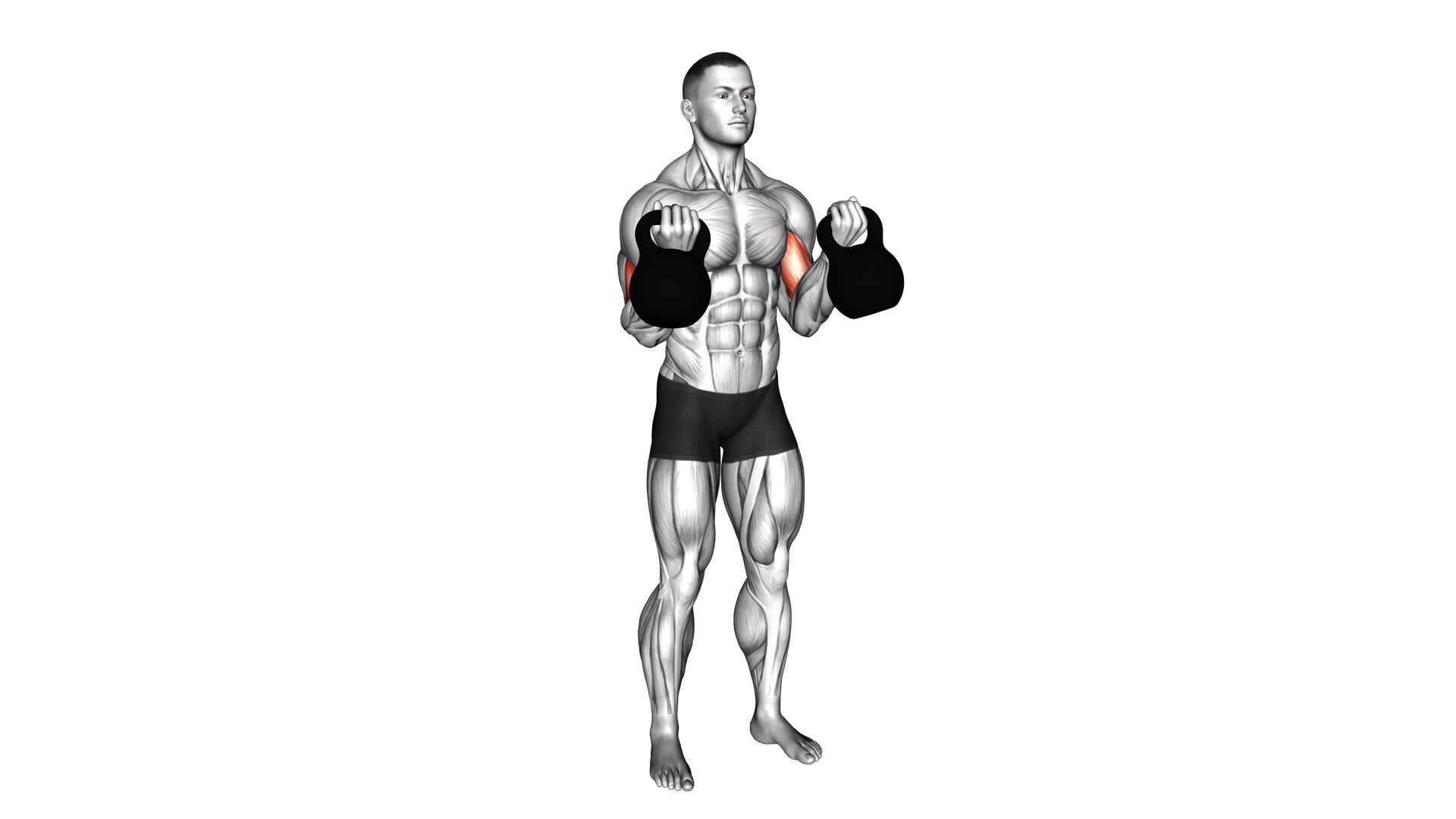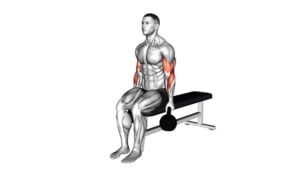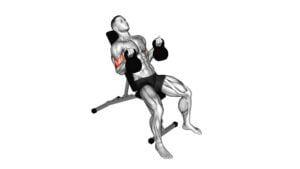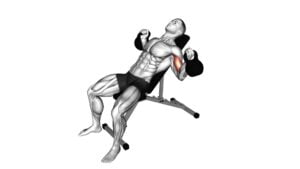Kettlebell Biceps Curl – Video Exercise Guide & Tips

Looking to build stronger biceps? The kettlebell biceps curl is a fantastic exercise for you.
Watch This Exercise Video
In this video exercise guide, we'll show you how to perform this movement with proper form and technique. You'll learn about selecting the right weight and how to progress over time.
We'll also cover common mistakes to avoid and introduce you to variations and advanced techniques.
Get ready to tone and strengthen those biceps with this effective kettlebell exercise.
Let's dive in!
Key Takeaways
- Kettlebell biceps curl strengthens biceps and improves arm muscle definition.
- It targets muscles in the upper arms, specifically the biceps brachii.
- It enhances grip strength and works multiple muscle groups simultaneously.
- Gradually increasing weight challenges muscles and helps build strength.
Benefits of Kettlebell Biceps Curl
When performing the kettlebell biceps curl, you can experience a range of benefits that include strengthening your biceps and improving your overall arm muscle definition. The kettlebell biceps curl is an effective exercise that targets the muscles in your upper arms, specifically the biceps brachii. By consistently including this exercise in your workout routine, you can achieve increased muscle definition in your biceps.
One of the key benefits of the kettlebell biceps curl is improved grip strength. As you hold onto the kettlebell and perform the curling motion, your forearms and hand muscles are engaged. This constant grip challenge helps to strengthen your grip, which can have a positive impact on other exercises and daily activities that require a strong grip.
Additionally, the kettlebell biceps curl is a compound exercise, meaning it works multiple muscle groups simultaneously. Alongside the biceps, this exercise also engages the muscles in your forearms, shoulders, and upper back. This can contribute to improved overall arm muscle definition and strength.
Proper Form and Technique
To perform the kettlebell biceps curl with proper form and technique, you should focus on maintaining a strong grip and engaging multiple muscle groups simultaneously.
One of the most common errors people make when performing this exercise is using a grip that's too loose. It's important to have a proper grip on the kettlebell to prevent it from slipping out of your hand and causing injury. To achieve a proper grip, make sure to wrap your fingers securely around the handle and keep your wrist in a neutral position.
Another common error is using only your biceps to lift the kettlebell. This can lead to strain and limited muscle activation. To engage multiple muscle groups, start by keeping your core tight and your shoulders back. As you curl the kettlebell up, focus on squeezing your biceps while also engaging your forearms and shoulders.
Weight Selection and Progression
To continue building strength and muscle with the kettlebell biceps curl, it's important for you to gradually increase the weight you're using, consistently challenging yourself with heavier loads. Weight selection plays a crucial role in your progress and development.
When choosing the appropriate weight for the kettlebell biceps curl, it's essential to consider your current fitness level and capabilities. Start with a weight that allows you to perform the exercise with proper form and technique while still feeling a moderate level of resistance.
As you become more comfortable and proficient with the movement, you can gradually increase the weight to continue challenging your muscles. It's important to note that exercise modifications can also be made to adjust the difficulty of the kettlebell biceps curl.
For example, if you find that the standard biceps curl is too challenging, you can try performing the exercise with a lighter weight or using both hands to curl the kettlebell. On the other hand, if you feel that the standard curl is too easy, you can experiment with heavier weights or try performing the exercise using one arm at a time.
Common Mistakes to Avoid
Avoiding common mistakes is crucial for effectively performing the kettlebell biceps curl and achieving your strength and muscle-building goals. By understanding and avoiding these mistakes, you can ensure that you're maximizing the benefits of this exercise.
One common mistake to avoid is using too much weight. While it may be tempting to lift a heavier kettlebell, it's important to remember that proper technique is key. Using too much weight can compromise your form and increase the risk of injury. Start with a weight that allows you to perform the exercise with proper form and gradually increase the weight as your strength improves.
Another mistake to avoid is using momentum to lift the kettlebell. The biceps curl is a controlled movement that should be performed with a slow and controlled tempo. Using momentum to swing the kettlebell up not only takes away from the effectiveness of the exercise but also puts unnecessary stress on your joints.
Lastly, avoid using your back to lift the kettlebell. The biceps curl is primarily a biceps exercise, so it's important to keep the focus on that muscle group. Keep your back straight and engage your core to maintain stability throughout the movement.
By avoiding these common mistakes and focusing on proper technique, you can ensure that you're getting the most out of your kettlebell biceps curl.
Now, let's move on to the next section to explore variations and advanced techniques that can further challenge your biceps muscles.
Variations and Advanced Techniques
Try incorporating different variations and advanced techniques into your kettlebell biceps curl routine for added challenge and muscle growth.
One way to vary your grip is by using an underhand grip instead of the traditional overhand grip. This can target your biceps from a different angle and engage different muscle fibers.
Another variation is the hammer grip, where your palms face each other throughout the movement. This grip emphasizes the brachialis muscle, which lies underneath the biceps and contributes to overall arm size and strength.
Tempo variations can also make your kettlebell biceps curls more challenging. Instead of performing the exercise at a regular pace, you can try slowing down the eccentric (lowering) phase of the movement. This increases time under tension and stimulates more muscle growth.
On the other hand, you can also try explosive concentric (lifting) contractions by quickly curling the kettlebell up. This recruits more muscle fibers and can lead to greater strength gains.
Incorporating these different grip and tempo variations into your kettlebell biceps curl routine can help break through plateaus and keep your workouts interesting.
Remember to start with lighter weights when trying new techniques and gradually increase the intensity as you become comfortable and confident with the movements.
Frequently Asked Questions
How Many Sets and Repetitions Should I Do for Kettlebell Biceps Curls?
For optimal results, you should consider the number of sets and repetitions for kettlebell biceps curls. It's important to find a balance that challenges your muscles without causing fatigue or injury.
Start with 2-3 sets of 8-12 repetitions and gradually increase as your strength improves. Remember to listen to your body and adjust accordingly.
Can Kettlebell Biceps Curls Help With Weight Loss?
Kettlebell biceps curls can indeed help with weight loss. When it comes to shedding those extra pounds, incorporating kettlebell exercises into your workout routine has numerous benefits.
Kettlebell biceps curls not only target and strengthen your arm muscles, but they also engage your core and lower body, increasing calorie burn and promoting overall fat loss.
Are Kettlebell Biceps Curls Suitable for Beginners?
Kettlebell biceps curls can be suitable for beginners as they target the biceps muscles effectively. To perform this exercise, maintain proper form and technique by keeping your back straight and lifting the kettlebell towards your shoulders.
However, if you're not comfortable with kettlebells, there are alternative exercises like dumbbell biceps curls or resistance band curls that can still help you strengthen your biceps.
It's important to choose a variation that suits your fitness level and goals.
Can Kettlebell Biceps Curls Cause Any Injuries?
Kettlebell biceps curls can potentially cause injuries if not performed with proper form. The most common injury associated with this exercise is a biceps strain. To avoid this, it's crucial to maintain proper technique throughout the movement.
Ensure that your elbows stay close to your body and avoid using momentum to lift the kettlebell. By following these guidelines, you can minimize the risk of injury and get the most out of your workout.
Is It Necessary to Warm up Before Performing Kettlebell Biceps Curls?
Before jumping into kettlebell biceps curls, it's important to warm up first. Warming up helps to prepare your muscles and joints for the exercise, reducing the risk of injury. It increases blood flow and flexibility, allowing for better performance and range of motion during the curls.
Additionally, it's crucial to maintain proper form and technique throughout the exercise to maximize its benefits and avoid strain on your muscles.
Conclusion
In conclusion, the kettlebell biceps curl is a highly effective exercise for strengthening and sculpting the biceps muscles. By maintaining proper form and technique, selecting the appropriate weight, and avoiding common mistakes, you can maximize the benefits of this exercise.
Additionally, there are variations and advanced techniques available to challenge yourself and continue progressing.
Incorporating kettlebell biceps curls into your workout routine can help you achieve stronger and more defined biceps.

Author
Years ago, the spark of my life’s passion ignited in my mind the moment I stepped into the local gym for the first time. The inaugural bead of perspiration, the initial endeavor, the very first surge of endorphins, and a sense of pride that washed over me post-workout marked the beginning of my deep-seated interest in strength sports, fitness, and sports nutrition. This very curiosity blossomed rapidly into a profound fascination, propelling me to earn a Master’s degree in Physical Education from the Academy of Physical Education in Krakow, followed by a Sports Manager diploma from the Jagiellonian University. My journey of growth led me to gain more specialized qualifications, such as being a certified personal trainer with a focus on sports dietetics, a lifeguard, and an instructor for wellness and corrective gymnastics. Theoretical knowledge paired seamlessly with practical experience, reinforcing my belief that the transformation of individuals under my guidance was also a reflection of my personal growth. This belief holds true even today. Each day, I strive to push the boundaries and explore new realms. These realms gently elevate me to greater heights. The unique combination of passion for my field and the continuous quest for growth fuels my drive to break new ground.







